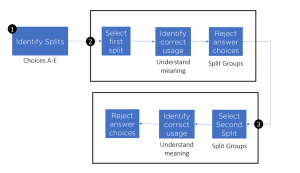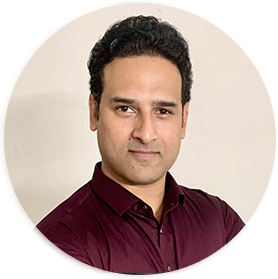To solve SC questions, students typically follow one of the two prevalent methods:
- Meaning-based method
- Splits method
While these methods differ in the sequence of steps prescribed, they have one thing in common – “meaning is central to both these methods”.

In this article, I will demonstrate that if you want to attain that 90th percentile in SC, then regardless of the approach that you use, you need to understand the meaning of the sentence.
And, after you read the article, I want you to ask this question to yourself – “Presently, what am I doing to build my skill set to understand the meaning?”
This article is divided into the following sections:
-
- Solved using the meaning-based method
- Solved using the splits method
- Take away – Meaning is central.
-
- Solved using the meaning-based method
- Solved using the splits method
- Take away – Meaning is central.
So, let’s get started!
1 Question 1
1.1 Question information
- Source – OG Verbal Review 2020
- Question # 292
- Question attempts statistics in the e-GMAT platform
- # of attempts = 3856
- % correct = 60% = categorized as medium difficulty question.
- popular incorrect choices: B – 12%, D – 19%
- Question statistics on GMAT Club
- Hard – 52% accuracy – based on 4781 attempts
1.2 Question
Schistosomiasis, a disease caused by a parasitic worm, is prevalent in hot, humid climates, and it has become more widespread as irrigation projects have enlarged the habitat of the freshwater snails that are the parasite’s hosts for part of its life cycle.
A. the freshwater snails that are the parasite’s hosts for part of its life cycle
B. the freshwater snails that are the parasite’s hosts in part of their life cycle
C. freshwater snails which become the parasite’s hosts for part of its life cycles
D. freshwater snails which become the hosts of the parasite during the parasite’s life cycles
E. parasite’s hosts, freshwater snails which become their hosts during their life cycles
Correct answer = A
1.3 Meaning-based Approach

Step 1 – Understand the meaning of the original sentence
- Schistosomiasis,
- a disease caused by a parasitic worm,
- is prevalent in hot, humid climates,
- a disease caused by a parasitic worm,
- and it has become more widespread
- as irrigation projects have enlarged the habitat of the freshwater snails
- that are the parasite’s hosts for part of its life cycle.
- as irrigation projects have enlarged the habitat of the freshwater snails
The student reads the sentence slowly to understand all the aspects of its meaning as identified below:
- Aspect 1 – Sch. is a disease that is caused by a parasitic worm.
- Aspect 2 – Sch. is present in certain types of climates.
- Aspect 3 – Sch. has become more widespread by certain projects.
- Aspect 4 – These projects have enlarged the habitat of specific freshwater snails (FWS).
- Aspect 5 – These FWS are the hosts for the parasite.
- Aspect 6 – These FWS are the hosts for a part of the parasite’s life cycle.
Step 2 – Identify the errors in the original sentence
Keeping in mind the meaning analysis, now the student evaluates the original sentence for any grammatical errors. And obviously, she focuses her attention on the underlined portion.
For the sake of demonstration, I will go through each error one by one and show you how the student reasons things out:
-
- SV – “that are” is the SV pair – logically ‘that’ refers to the FWS plural – both SV plural – so ok.
- Verbs – the sentence is set up in present tense – logically ok.
- Pronouns – ‘its’ refers to parasite – logically ok.
- Modifiers – ‘that’ refers to FWS – logically ok.
- Parallelism – no list
Notice carefully – for evaluation of each grammar error, she refers to her understanding of the meaning of the sentence. Notice the word “logically” in all the four applicable grammar error categories.
Step 3 – Analyze answer choices
Now she takes the meaning analysis (and when applicable error analysis) with her to analyze each answer choice one by one.
At this point as well, she focuses her attention primarily on the underlined portion of the sentence. So, from the meaning standpoint, aspects 1, 2, and 3 are all from the non-underlined portion.
So, she does not worry about them.
-
- Aspect 4 – These projects have enlarged the habitat of specific freshwater snails (FWS).
- Aspect 5 – These FWS are the hosts for the parasite
- Aspect 6 – These FWS are the hosts for a part of the parasite’s life cycle.
So, her checklist for each choice now contains the typical grammar error categories (SV, Verbs, Pronouns, Modifiers, Parallelism, Idioms) and these three aspects from the meaning analysis.
Let’s now see how the student analyzes each choice to find the correct answer.
1.3.1.1 Choice B
the freshwater snails that are the parasite’s hosts in part of their life cycle
-
- Aspects 4 and 5 – ok
- Aspect 6 – distorted – ‘their’ refers to the plural ‘snails’. Thus, per this choice, the life cycle of snails is being talked about instead of the life cycle of the parasite.
Thus, this choice is incorrect.
1.3.1.2 Choice C
freshwater snails which become the parasite’s hosts for part of its life cycles
-
- Aspects 4, 5, 6 – all ok.
- Grammar issue – ‘life cycles’ implies that the parasite has more than one life cycle. This is illogical.
Thus, this choice is incorrect.
1.3.1.3 Choice D
freshwater snails which become the hosts of the parasite during the parasite’s life cycles
-
- Aspects 4 and 5 – ok
- Aspect 6 – distorted – the key part of aspect 6 has been removed – that the snails are hosts for a part of the parasite’s life cycle – “part” has been removed from this choice.
Thus, this choice is incorrect.
1.3.1.4 Choice E
parasite’s hosts, freshwater snails which become their hosts during their life cycles
-
- Aspect 6 – distorted – same issue as in Choice D.
Thus, this choice is incorrect.
Hence choice A is the correct answer.
Summary – meaning-based method
As you can see, the student begins with understanding the meaning of the sentence and then utilizes this analysis to find the correct answer. Thus, meaning is central to the meaning-based method.
Now we will see how a student uses the splits method to solve this question.
1.4 Splits approach

Step 1 – Identify the splits.
The student will review the answer choices and arrive at the following ‘splits’.
-
- the freshwater snails / freshwater snails
- its / their
- life cycle / life cycles
- part of / during
- that are / which become
The answer choices have been color-coded based on the identified splits.
A. the freshwater snails that are the parasite’s hosts for part of its life cycle
B. the freshwater snails that are the parasite’s hosts in part of their life cycle
C. freshwater snails which become the parasite’s hosts for part of its life cycles
D. freshwater snails which become the hosts of the parasite during the parasite’s life cycles
E. parasite’s hosts, freshwater snails which become their hosts during their life cycles
Step 2 – Reject answer choices utilizing the first split.
Let’s say that the student selects the easiest split of all “its / their”. Now from purely grammatical perspective, any of the two pronouns will work. But to determine which one is correct in this sentence, the student will need to understand the context of the sentence.
Schistosomiasis, a disease caused by a parasitic worm, is prevalent in hot, humid climates, and it has become more widespread as irrigation projects have enlarged the habitat of the freshwater snails that are the parasite’s hosts for part of its life cycle.
Now the student will read the sentence and understand its context to determine what ‘its’ is intended to refer to. She applies her skill set to read and understand the sentence and determines that logically, ‘its’ should refer to parasite. Thus, ‘their’ is incorrect because by virtue of being plural, it refers to the snails and this reference is illogical in the context of this sentence.
Thus, the student will reject all the choices that use ‘their’.
Thus, B and E are eliminated.
Step 3 – Utilizing the second split, reject the next set of answer choices.
Upon close examination of remaining choices and the splits identified, the student picks up the split “part of / during”. Now she re-reads the sentence to determine which one of the two is correct.
As she reads the sentence again, this time focusing on – part – specifically, she realizes that the author intended to say that the snails are hosts for only a part of the life cycle. Thus, as it stands, ‘during’ distorts the meaning.
So, Choice D is eliminated.
Step 4 – Based on the choices left, select the third split and arrive at the correct answer.
Between A and C, now the next split is “life cycle/ life cycles”. Now the student already knows that the parasite’s life cycle is being talked about. Logically, a living being has only one life cycle. Thus, “life cycles” is incorrect.
Hence choice C is eliminated.
Choice A is hence the correct answer.
Summary – Splits method
This is a 700-level question.
The answer choices in this question had 5 different pairs of splits and to arrive at the correct answer, the student had to utilize three splits (i.e. 3 iterations).
In each iteration, the student had to leverage the intended meaning to narrow down the answer choices (i.e. reject the incorrect ones). This is because, apart from splits that are based purely on idioms such as “less than”, “between and” or that are simple subject-verb pairs, almost all other splits require evaluation by understanding the meaning of the sentence.
Thus, even when using the “splits approach” meaning becomes central to solving most SC questions.
We will now take one more question to drive home this point.
2. Question 2
2.1 Question information
- Source – OG Advanced Book
- Question # 268
- Question statistics on GMAT Club
- Hard – 30% accuracy – based on 529 attempts
2.2 Question
An archaeological excavation at what might have been a workshop where statues were reproduced yielded 1,532 fragments of human figures, including 7 intact statues.
A. what might have been a workshop where statues were reproduced yielded 1,532 fragments of human figures, including
B. what might have been a workshop where statues were reproduced yielded 1,532 fragments of human figures and
C. the site of a possible workshop where statues were reproduced yielded 1,532 fragments of human figures and
D. the site of a possible workshop where statues were reproduced yielded 1,532 fragments of human figures, including
E. the site of a possible workshop where statues might have been reproduced yielded 1,532 fragments of human figures, including
Correct answer = B
2.3 Meaning-based Approach
Step 1 – Understand the meaning of the original sentence
-
- An archaeological excavation at what might have been a workshop where statues were reproduced yielded 1,532 fragments of human figures, including 7 intact statues.
The student reads the sentence slowly to understand all the aspects of its meaning as identified below:
-
- Aspect 1 – An archaeological excavation generated a large number of pieces of human figures.
- Aspect 2 – these pieces included seven intact statues
- Aspect 3 – This excavation spot may have been a workshop where statues were reproduced.
Now as the student confirms her understanding of the sentence, she notices something peculiar in the logic of the sentence. As written, the sentence implies that the 1532 pieces of human figures included the 7 intact statues.
This is illogical because it does not make sense to say that pieces include intact statues. Thus, this sentence has a logical error.
Now, based on the information in the sentence, the student infers the logical intended meaning. The excavation was on the site where there may have been a workshop in which statues were reproduced.
Now it is logical to say that in this workshop, fragments were taken to create intact statues or to reproduce these full statues.
With this understanding, the student understands that the sentence intended to communicate the following:
-
- Aspect 1 – An archaeological excavation generated a large number of pieces of human figures.
- Aspect 2 – In addition to the fragments discovered, the excavation also generated seven intact statues.
- Aspect 3 – This excavation spot may have been a workshop where statues were reproduced
Step 2 – Identify the errors in the original sentence
Keeping in mind the meaning analysis, now the student evaluates the original sentence for any grammatical errors.
In this sentence, she does not find any glaring grammatical errors.
So, the only error in this sentence is the meaning error that the student identified as she verified her understanding of the meaning of the sentence.
Step 3 – Analyze answer choices
Now she takes the meaning analysis (and when applicable error analysis) with her to analyze each answer choice one by one.
So, her checklist for each choice now contains the typical grammar error categories (SV, Verbs, Pronouns, Modifiers, Parallelism, Idioms) and all the three aspects from the meaning analysis.
Let’s now see how the student analyzes each choice to find the correct answer.
2.3.1.1 Choice B
what might have been a workshop where statues were reproduced yielded 1,532 fragments of human figures and
-
- The logic error has been corrected; i.e. all aspects have been expressed correctly
- No grammatical error has been introduced
Thus, this choice is correct.
2.3.1.2 Choice C
the site of a possible workshop where statues were reproduced yielded 1,532 fragments of human figures and
-
- Aspects 1 and 2 are correct.
- But aspect 3 has been distorted.
- Per the logical intended meaning, the excavation was done at a site at which in the past there was probably this workshop where the statues were reproduced.
- Per this choice, the excavation was done at the site where this workshop was possible or feasible.
- And hence aspect 3 has been distorted in this choice.
Thus, this choice is incorrect.
2.3.1.3 Choice D
the site of a possible workshop where statues were reproduced yielded 1,532 fragments of human figures, including
-
- Aspect 1 is ok
- Aspect 3 is distorted as in choice C
- Aspect 2 is distorted as in choice A
Thus, this choice is incorrect.
2.3.1.4 Choice E
the site of a possible workshop where statues might have been reproduced yielded 1,532 fragments of human figures, including
-
- Same errors as in choice D
Hence choice B is the correct answer.
Summary – meaning-based method
As you can see, answering this question requires a razor-sharp focus on the meaning of the sentence.
In fact, not even a single choice in this question can be rejected based on a grammatical error. In addition, in this question, the student went a step ahead. She not only understood what the sentence communicated, but she also questioned if that meaning is logical.
In this case, the meaning was indeed illogical. And accordingly, the student inferred the logical meaning based on the information provided in the sentence and then took that meaning with her to evaluate the answer choices.
Now we will see how a student will use splits method to solve this question.
2.4 Splits approach
Step 1 – Find the similarities and dissimilarities among the choices
An archaeological excavation at what might have been a workshop where statues were reproduced yielded 1,532 fragments of human figures, including 7 intact statues.
A. what might have been a workshop where statues were reproduced yielded 1,532 fragments of human figures, including
B. what might have been a workshop where statues were reproduced yielded 1,532 fragments of human figures and
C. the site of a possible workshop where statues were reproduced yielded 1,532 fragments of human figures and
D. the site of a possible workshop where statues were reproduced yielded 1,532 fragments of human figures, including
E. the site of a possible workshop where statues might have been reproduced yielded 1,532 fragments of human figures, including
The student will review the answer choices and arrive at the following ‘splits’.
-
- What might have been a workshop / the site of a possible workshop
- figures, including / figures and
- statues might have been reproduced / statues were reproduced
Step 2 – Select the first split, find which one is correct, and reject the choices accordingly.
-
- Let’s say the student selects the first split – What might have been a workshop / the site of a possible workshop.
- She will now read the original sentence to determine what the author wants to communicate and then determine the correct one.
- Based on the reasoning explained in the meaning-based solution, she will conclude that “what might have been a workshop” is correct.
- She will thus eliminate choices C, D, and E.
Step 3 – Based on the choices left and the deterministic nature of the split, select the second split.
-
- Next, the student will pick the split – figures, including / figures and
- And once again, she will refer to the logical meaning intended to be communicated by the original choice.
- Based on the reasoning explained in the meaning-based solution, she will conclude that “figures, including” is incorrect.
- She will thus eliminate choice A and select choice B as the correct answer.
Summarize splits method
Even though this example contained just 3 groups of splits, determining the correct split required that the student understood the intended meaning.
Therefore, regardless of the approach (meaning-based or splits based), understanding the meaning is central to solving GMAT Sentence Correction questions, especially if you want to score in the 90th percentile.
Thus, meaning is central to SC, even for the splits approach.
Putting it all together
To summarize, regardless of which method you use to solve Sentence Correction questions, in order to solve difficult questions in SC, you need to understand the meaning of the sentence.
You have to be 100% sure about what the sentence intends to communicate. You need to know the role played each and every segment of the sentence. Not only that, as we saw in question 2, you also need to verify if the sentence is logical. And in the cases in which it is not logical, you need to infer the intended logical meaning.
GMAT is a test of your ability to solve difficult questions. So, as you prepare for SC, ask yourself this one question – “What am I doing to build my ability to read and understanding 100% of the meaning communicated by the sentence?”
Refer to the following articles for concepts and tips related to GMAT sentence correction:
- A primer on Noun phrases and Noun Modifiers | GMAT Sentence Correction
- Modifier Errors | GMAT Sentence Correction
- GMAT and Meaning – Part 2: Strategy 2 – Use of Modifiers
- GMAT and Meaning – Part 3: Strategy 3 – Change of Conjunctions
- GMAT and Meaning – Part 4: Strategy 4 – Change of Voice
- GMAT and Meaning – Part 5 – Change/Remove Words that provide Context













